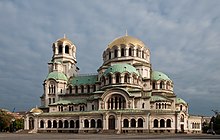
Back إحياء العمارة البيزنطية Arabic Неовизантийски стил Bulgarian Arquitectura neobizantina Catalan Novobyzantský sloh Czech Neobyzantinische Architektur German Arquitectura neobizantina Spanish Uusbütsantsi stiil Estonian Architecture néo-byzantine French אדריכלות נאו-ביזנטית HE Neobizantska arhitektura Croatian



Neo-Byzantine architecture (also referred to as Byzantine Revival) was a revival movement, most frequently seen in religious, institutional and public buildings. It incorporates elements of the Byzantine style associated with Eastern and Orthodox Christian architecture dating from the 5th through 11th centuries, notably that of Constantinople (present-day Istanbul) and the Exarchate of Ravenna.
Neo-Byzantine architecture emerged in the 1840s in Western Europe and peaked in the last quarter of the 19th century with the Sacré-Coeur Basilica in Paris, and with monumental works in the Russian Empire, and later Bulgaria. The Neo-Byzantine school was active in Yugoslavia in the interwar period.
© MMXXIII Rich X Search. We shall prevail. All rights reserved. Rich X Search